ESFAHAN | Esfahan (or Isfahan as it’s also known in English), is the 3rd largest city in Iran and has at various times in its past served as the capital of Iran – at one stage it was one of the biggest cities in the world. Evidence of this is obvious when walking around the city, which is full of beautiful architecture and public spaces such as the UNESCO heritage listed Naqsh-e Jahan Square, one of the largest public squares in the world. When it comes to food, Esfahan is no slouch either and along with a range of delicacies that can be found throughout Iran, the city is also home to several regional delicacies.
Unsurprisingly, given the lack of international tourism to Iran over the past few decades, there’s not that much in the way of useful information on where to eat in Esfahan. TripAdvisor and Lonely Planet are resources that come up a lot however as with every other city in the world, these aren’t exactly full of the best tips going around. Indeed our Lonely Planet guide to Iran, despite being the most up-to date version, was full of incorrect and outdated information, regarding not just food, but a variety of things.
What all of this meant is that I had to do a lot more research than usual to try and pinpoint any “must try” places and even then, I often came up short in my attempts. When I arrived in Tehran, I soon discovered that a lack of English signs on store fronts was going to make things even more difficult, and in Tehran the situation was no different. So what then, did I have? A few places that my research had brought up (some which as it turned out were no longer open), my own instinct and sense of smell (always follow your nose and look for locals lining up for food) and our guide Vahid. Thankfully these things combined meant that I ate some amazing food in Esfahan
This food guide is broken down into food types, and then places where you can find them. Where possible, exact addresses are provided, and where not, the street and nearest intersecting street will be listed to get you close to where you need to be. I hope you enjoy reading through my Esfahan food guide and that it helps you enjoy some great food while in Esfahan.
To find out where and what to eat in Tehran, check out my Tehran Food Guide. For tips on where and what to eat in Shiraz, visit my Shiraz Food Guide.
Buffets & Traditional Restaurants
I know what you’re thinking and I can assure you that I thought the same thing too when I went to my first buffet in Iran. The thing about Iran is that the word buffet isn’t instantly synonymous with terrible. The reason for this is because the kind of food served at the buffets lends itself to this style of serving and, at the popular buffets, the food rotates fast so you don’t get the situation where there’s been food sitting in a bain-marie for ages. Quite often, you’ll have a salad bar scenario where the salads are at a buffet and the meat is cooked to order, which to my mind is what you want to be looking out for.
Buffets are popular with locals for family dinners on special occasions. It provides people with an opportunity to eat some of the foods that they wouldn’t get an opportunity to make at home due to implacability. I.e. not everyone in Iran has access to a big, proper charcoal BBQ with which to properly cook kebabs. Note that at a lot of these traditional restaurants there will be a mixture of buffet dishes and cooked to order meals, meaning the stuff that should be cooked fresh is. Below are some of the common dishes you’ll find at a buffet and traditional restaurant in Iran.
Salad
Some of the usual types of salad you’ll find at an Iranian buffet include fresh cucumber, tomato and white cheese salad, olives, pickles, pasta salad, corn, yoghurt and coleslaw.
Chelo Kebab
As described earlier, the salad at these places will usually be buffet style. If you see the meat in the buffet too you’ll want to be avoiding it as all the good places cook their meat (and sometimes rice) to order. Chelo kebab consists of steamed rice (chelo) and kebab (skewered meat that’s been grilled over hot charcoal), with grilled tomatoes (and sometimes grilled peppers) and buttery rice. There are several types of kebabs which are commonly served these include:
- Kabab Barg (lamb, chicken or beef fillet)
- Kabab Koobideh or Kubideh (minced lamb, beef, or chicken, often mixed with parsley and chopped onions.)
- Joojeh Kabab (chicken marinated in minced onion, lemon juice and saffron)
- Kabab Chenjeh (lamb chop)
- Mahi Kabab (white fish)
Persian rice is famous around the world. It’s a very long grain basmati rice which is highly aromatic. It’s fluffy texture comes from the fact that steaming is part of the process which ensures that each grain is separate from the others. Common rice dishes served with Chelow Kebab include:
- Chelo (white rice topped with a bit of saffron rice and barberries. Similar to pilaf)
- Adass Polo (white rice cooked simultaneously with lima beans, dill and garlic)
Here are 2 of the many places you can find traditional food in Shiraz. One great, one merely ok.
Name Unknown
When you leave the old part of Esfahan you’ll find the much more modern part of town. A few minutes walk south of where Sio Se Pol Bridge crosses the Zayanderud is this restaurant. I couldn’t find a name for it but it was very popular and full of locals. The food here was excellent – some of the best traditional Persian food I ate in Iran.
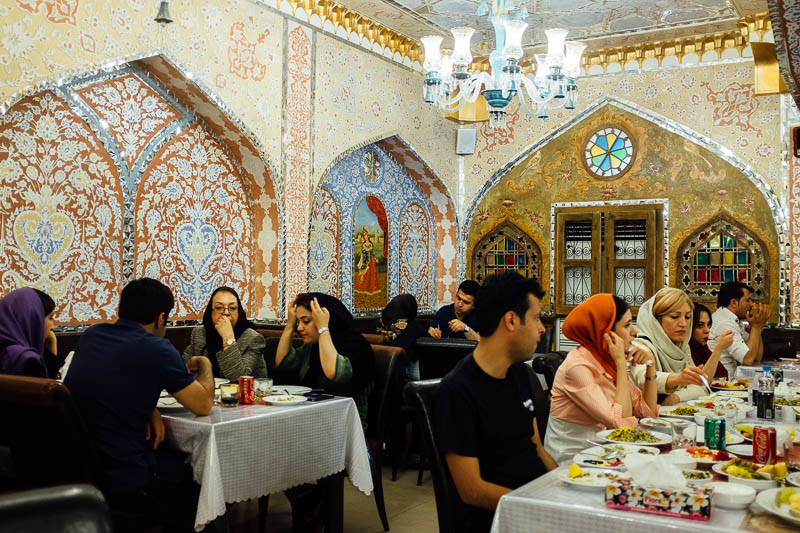
I had the opportunity to try Khoresht e-Mast, a very thick, almost glue like meat stew made from yogurt, lamb/mutton or chicken, saffron, sugar and orange peels. It’s very sweet and heavy and not the kind of thing you want a lot of, but worth trying as it’s unlike anything you’ve probably ever tried before.
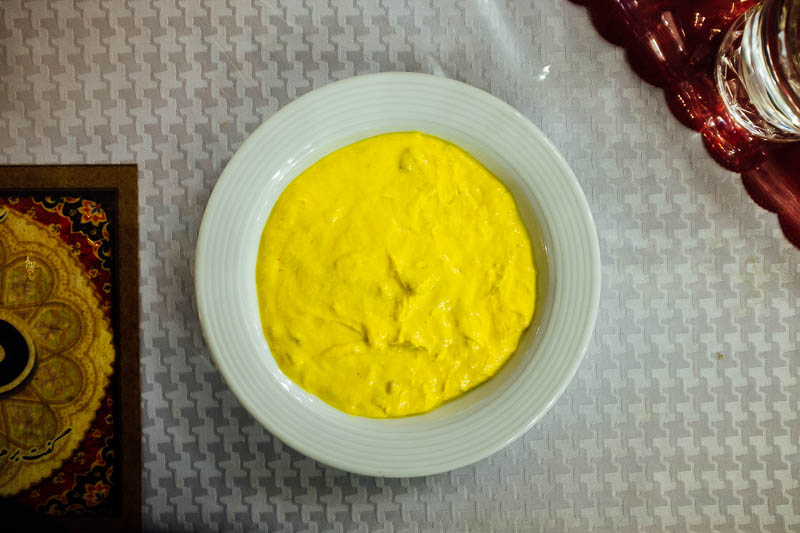
A tasty beef kabab koobideh.
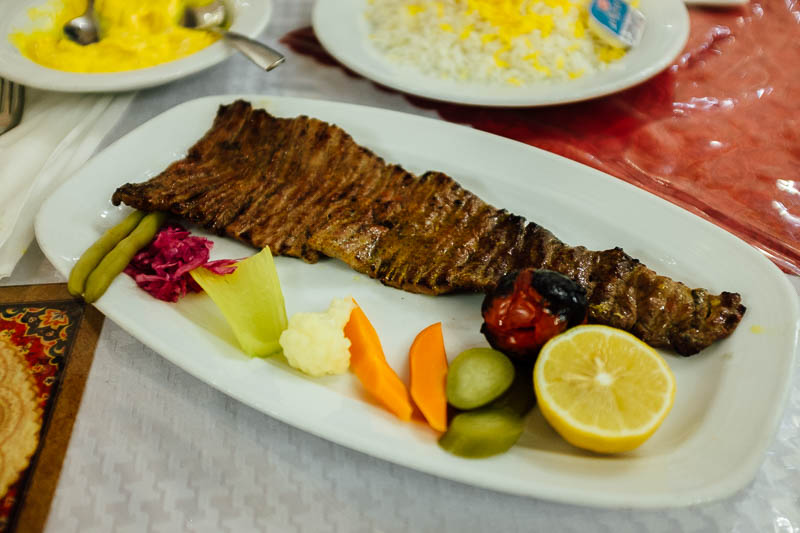
The lamb chops were particularly divine.
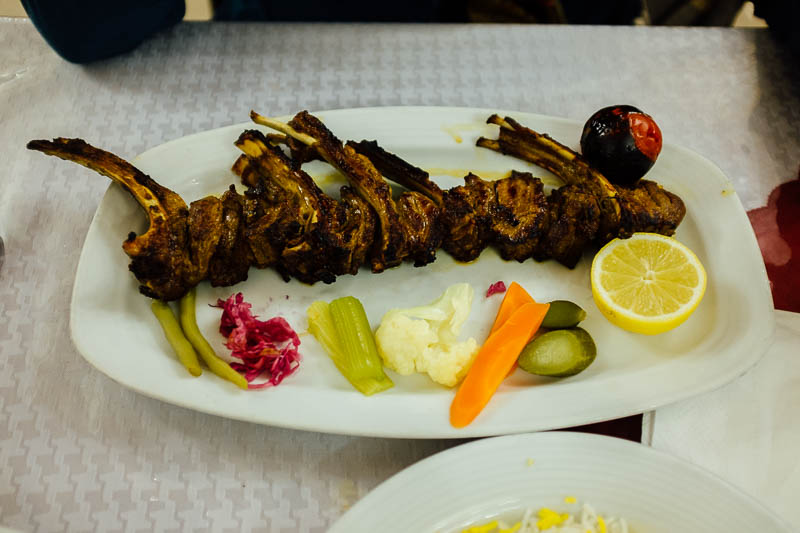
Saffron rice is almost always served with butter on the side.
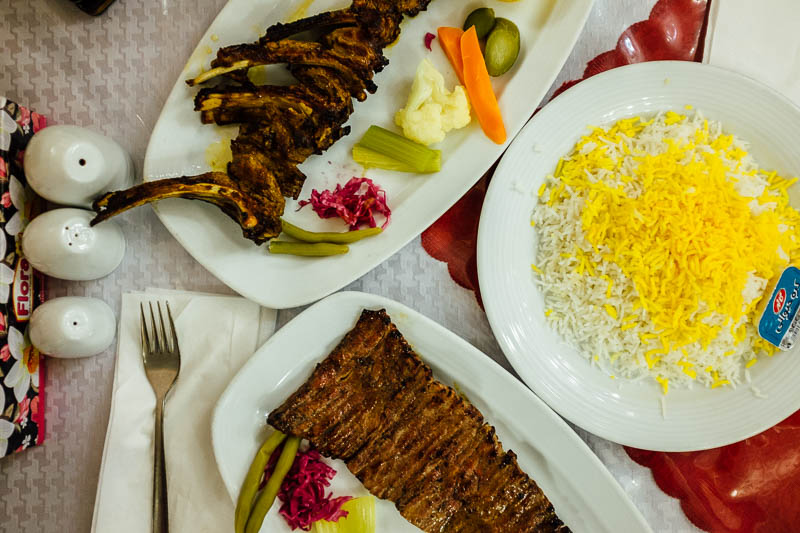
Name Unknown
Chahar Bagh e Bala Avenue (first block of shops, just up from the intersection with Melat Boulevard)
Esfahan
Bastani Traditional Restaurant
If you’re visiting the sights around Naqsh-e Jahan Square this is one of the restaurants you’ll likely see. This place appears in a lot of guides and while the food isn’t bad as such, there are better options out there. There’s not doubting that it’s visually appealing however.
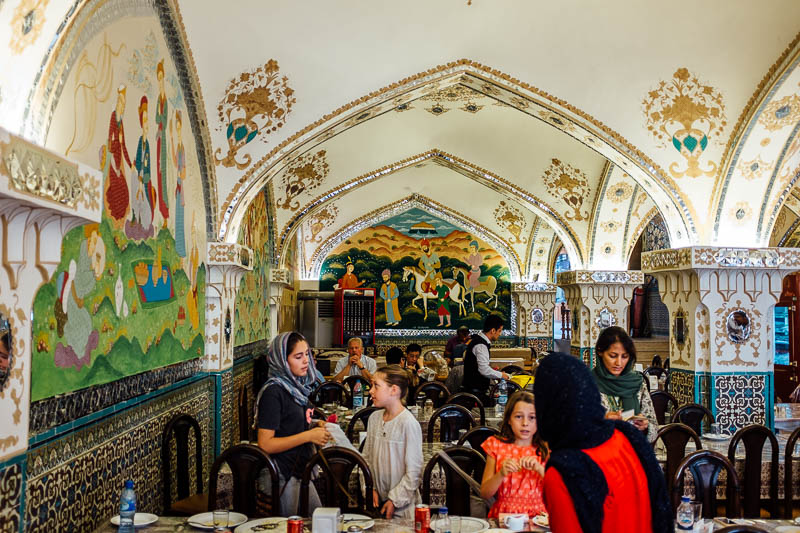
The rice kofta were quite tasty.
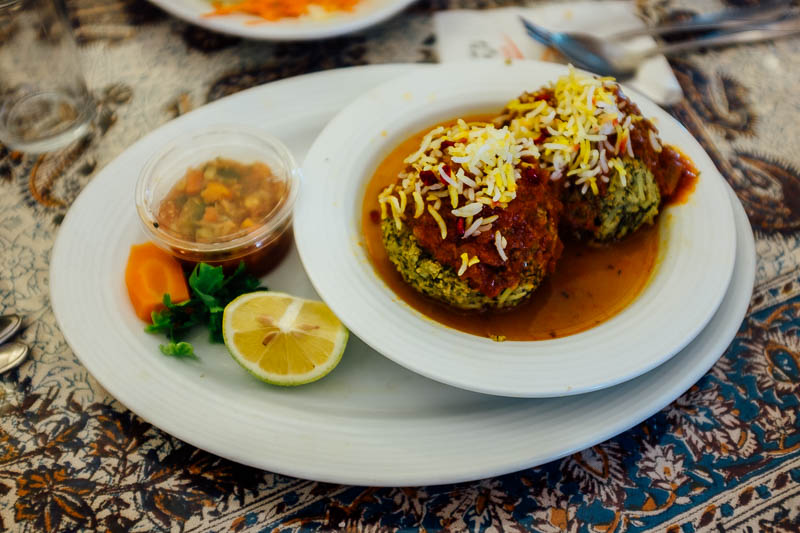
“Traditional” might be a bit of a stretch. I didn’t see this on any other menus during my time in Iran and it was merely ok.
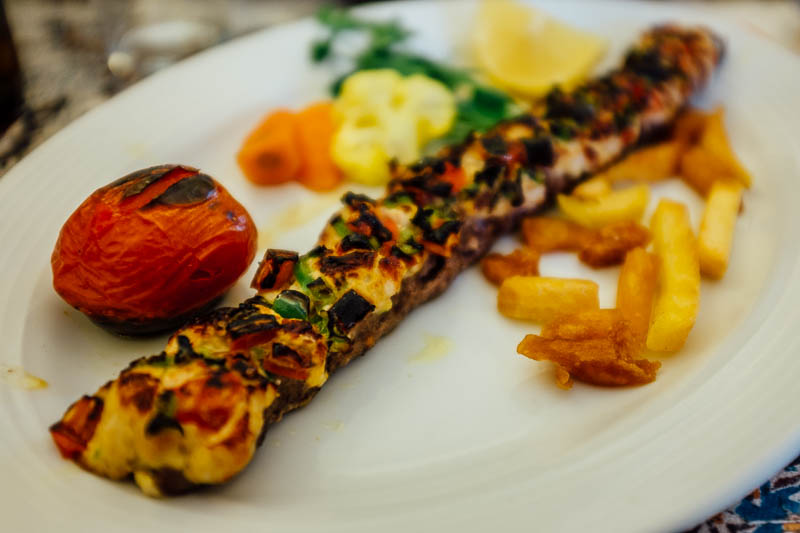
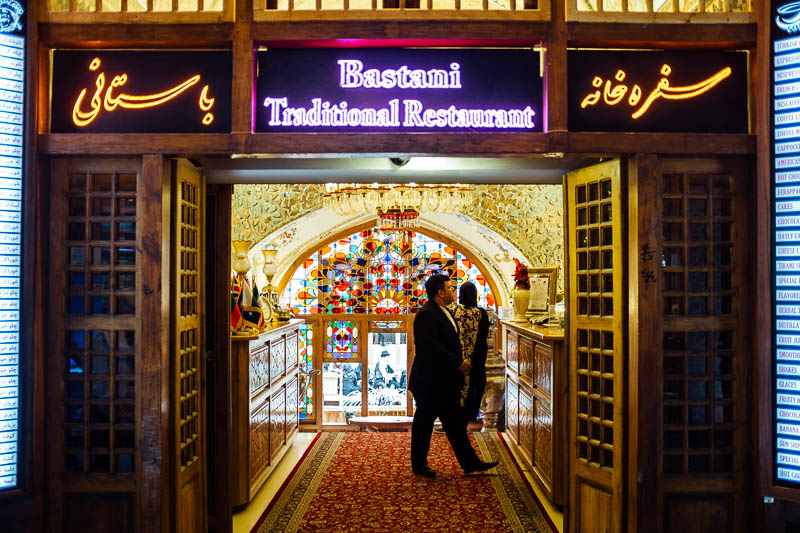
Bastani Traditional Restaurant
Naqsh-e Jahan Square/Imam Square
Esfahan
Khan Gostar
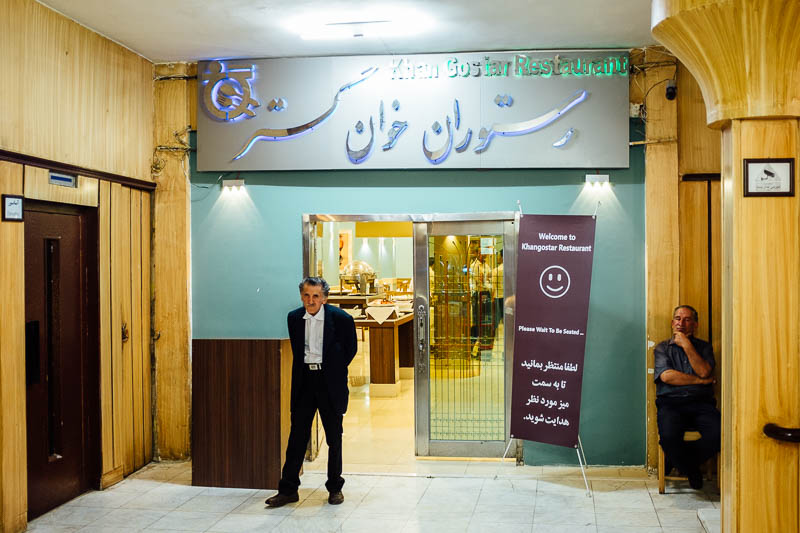
Khangostar comes up on a range of lists as a place that’s worth visiting for traditional food in Esfahan. I did make a visit there however the place was empty despite it being what should have been peak dinner time on a weekend evening in an area that was full of packed restaurants. To me, this was enough of a reason to eat elsewhere but you may want to try your luck.
Khan Gostar
Jolfa Hotel, Hakim Nezami Street
Esfahan
Bread
Bread is a staple in Iran. The most common form of bread is by far the thin, unleavened pita style what flour flatbread, which differs by region but is basically the same throughout the country. The 4 most common types of bread in Iran are:
- tāftūn (taftān)
- lavāš (nān-e tīrī)
- nān-e sangak
- nān-e barbarī
Hole in the wall bakeries like the one pictured below (photo from Shiraz) operate seemingly all day, kneading dough, rolling it out into thin disks and baking it quickly in a wood fired oven. Most of these bakeries seem to have a permanent line of people waiting to buy their daily bread, before moving it to a cooling rack at the front of the store where it can be cut to a more manageable size, put in a bag and taken away. There’s no need to search out any particular bakery – simply look around and you’ll soon spot a popular one.
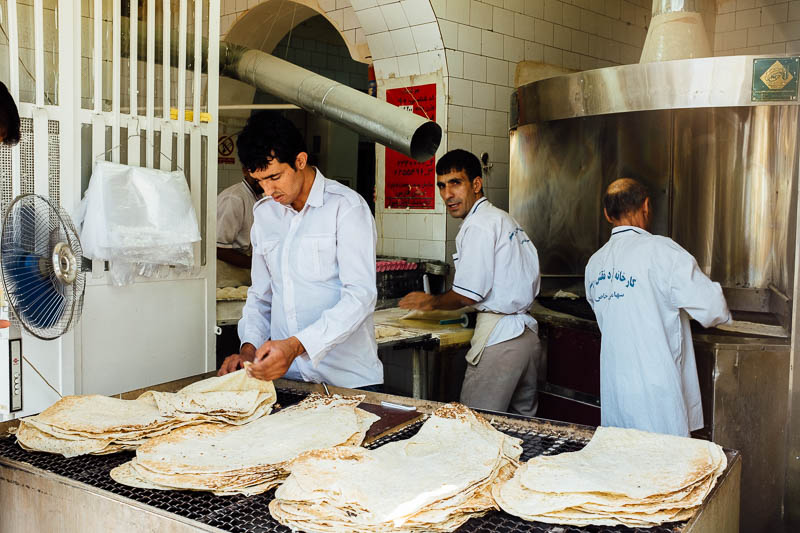
Cafes
Cafes and specialty coffee shops that would be instantly recognisable to any Westerner can be found throughout the major cities in Iran. Just like any other cafe, a variety of drinks and cakes are offered.
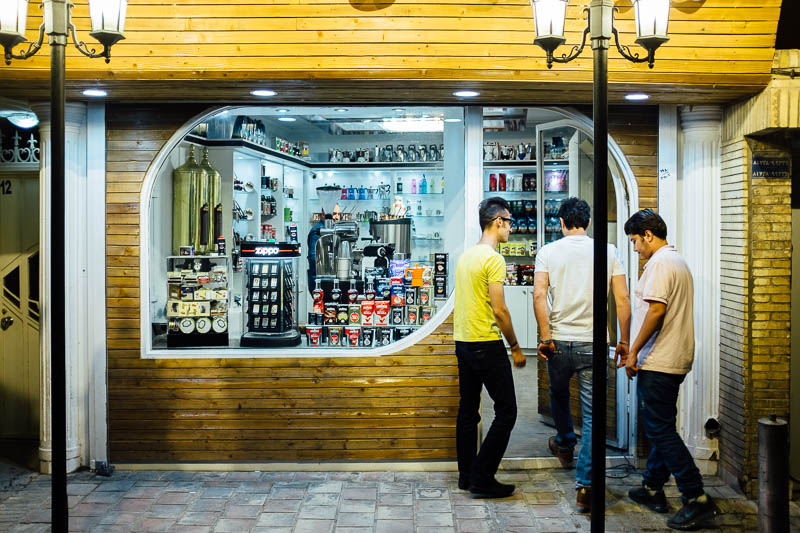
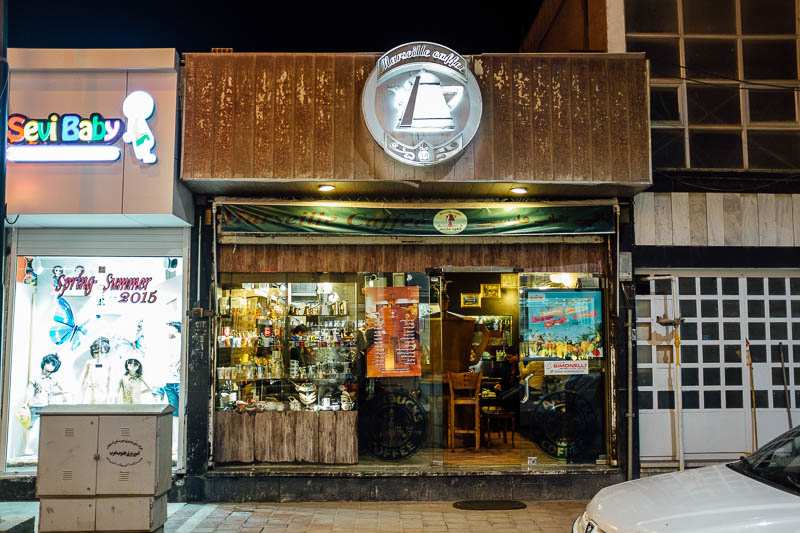
Sibil Coffee
This little cafe, which only has a few seats outside, is well worth seeking out. There’s a good selection of coffee based drinks and juices and the staff are really friendly.
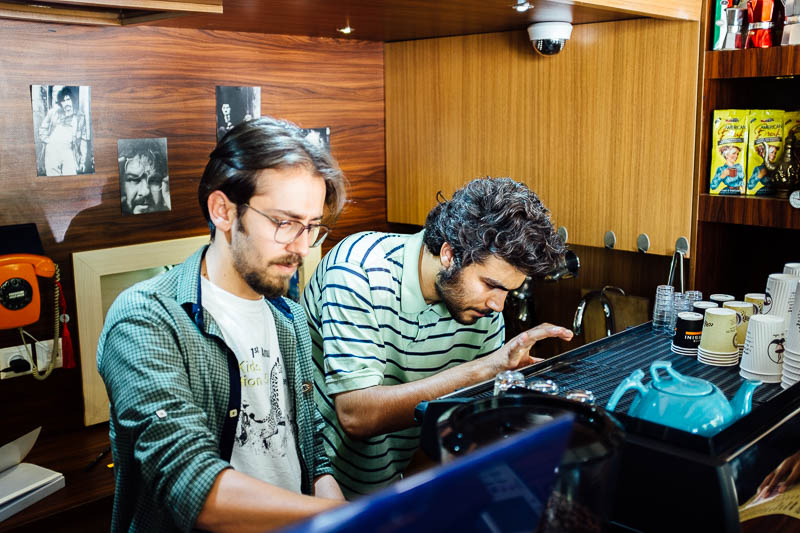
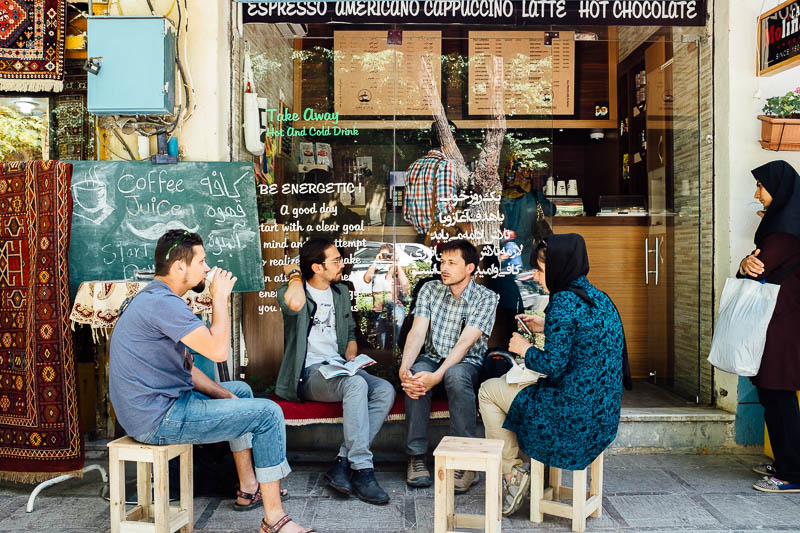
Sibil Coffee
Ostandari Street (near Posht Matbakh Alley)
Esfahan
Azadegan Tea House
This place is hidden down the end of a passageway lined with antiques. Find it though, and you’ll be treated to one of the coolest spaces in Esfahan. Whether you want to drink some tea, smoke some shisha or have some snacks, this is the perfect chill out spot.
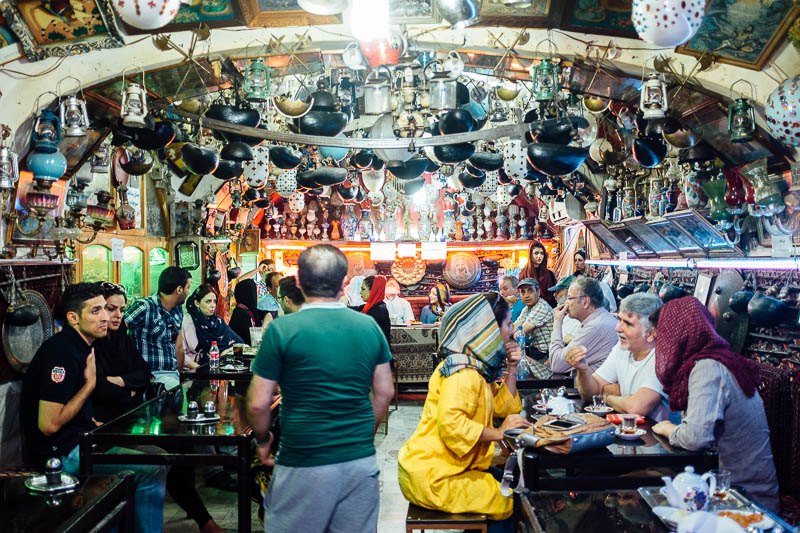
We bumped into this guy, who we found out is a popular Iranian TV game show host.
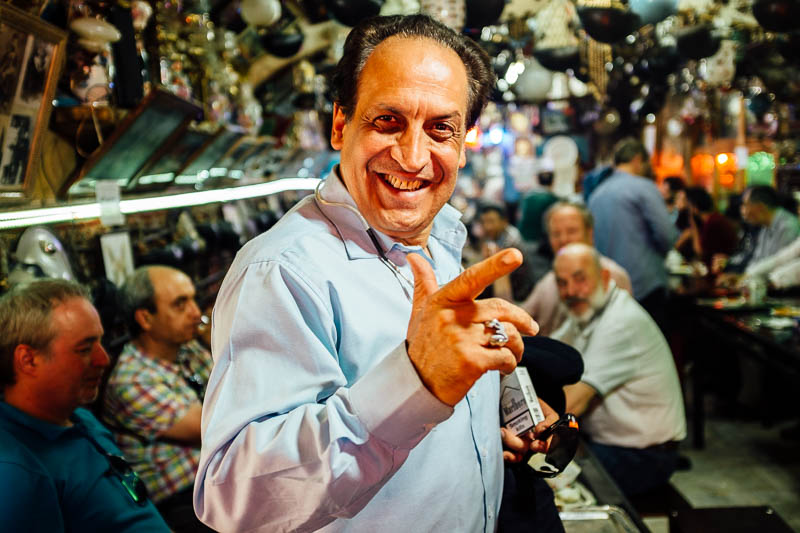
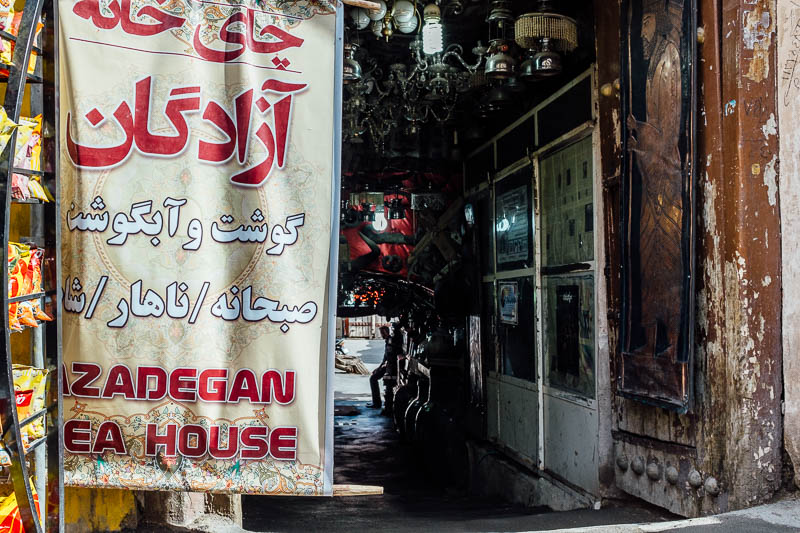
Azadegan Tea House
Ostandari Street (near Posht Matbakh Alley)
Esfahan
Firouz Sherbat
If you’re visiting the Armenian Vank Cathedral (or even if you’re not), you should definitely pop into Firouz Sherbat for a drink or some snacks. Along with coffee and tea, a good range of other drinks and desserts are offered. The interior is very quaint and cozy and it’s the kind of place you don’t want to leave.
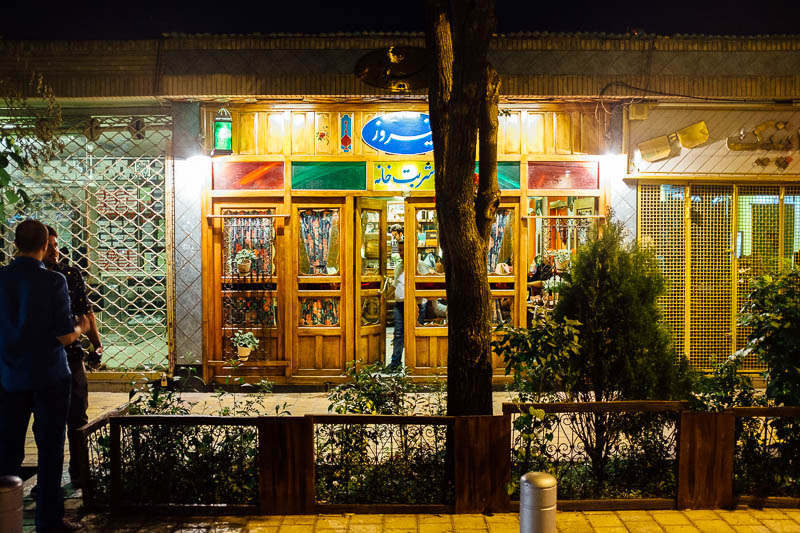
The lemon sherbet drink was cold and refreshing – a perfect respite from the heat.
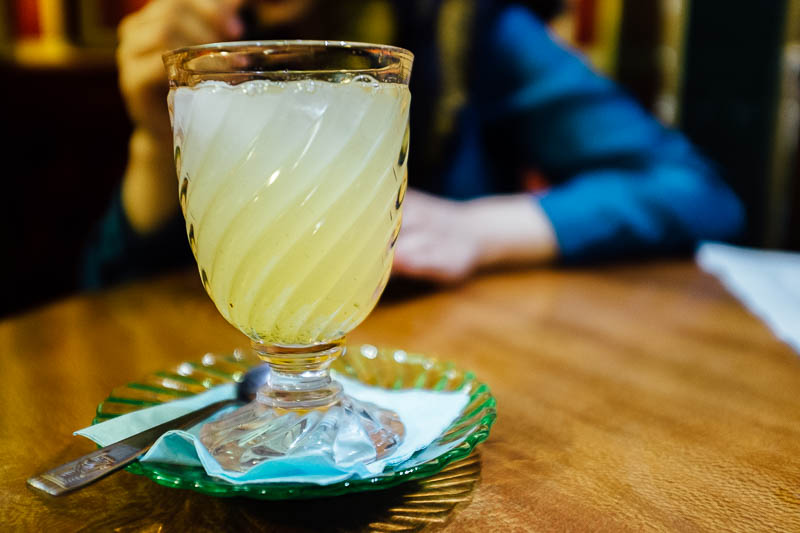
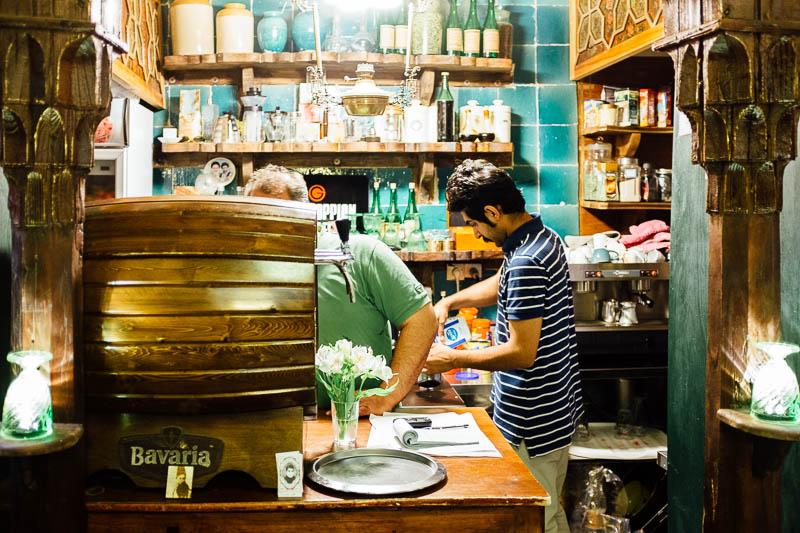
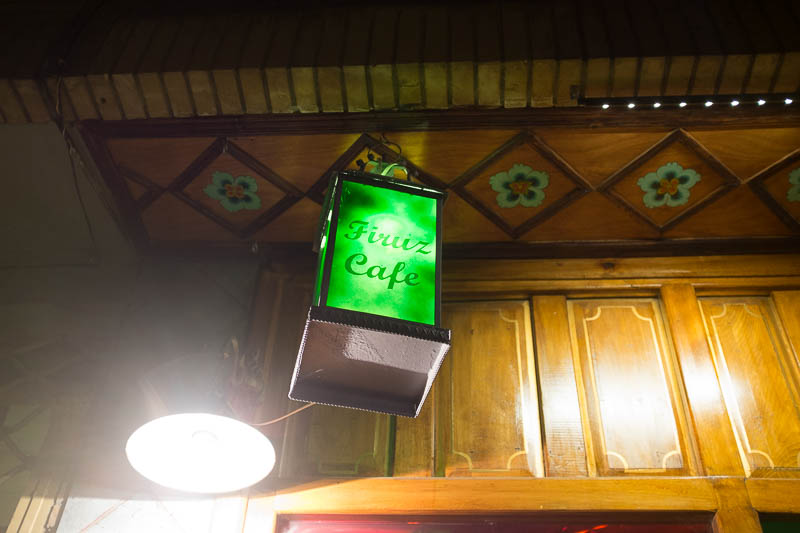
Firouz Sherbat
Jolfa Street/Hakim Nezami Street (near the Vank Cathedral)
Esfahan
Tea
Alcohol might be banned in Iran but you’ll have no trouble finding hot tea, which is served with practically every meal you eat. It’s served without milk, and generally comes with a choice of either white sugar cubes or saffron sugar crystals on a stick. I’ve not listed any specific places from which to get tea beyond those already listed in this guide as it’s everywhere.
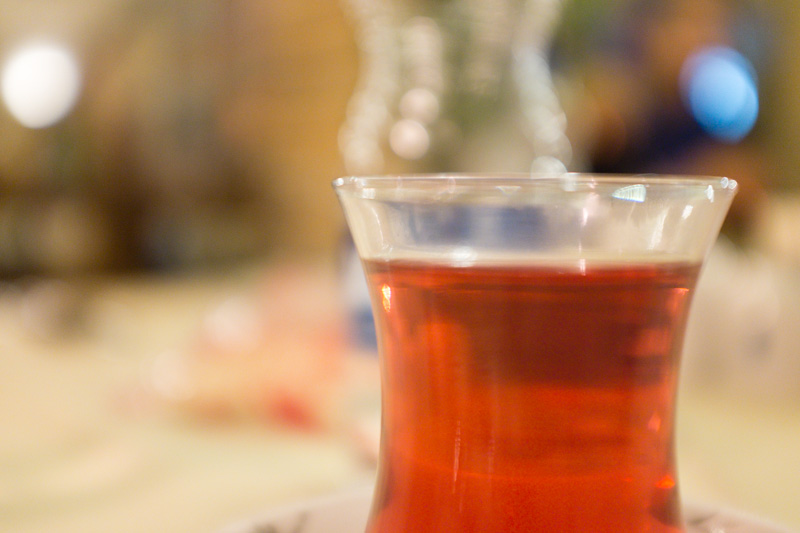
Alcohol
Alcohol is, of course banned in Iran. What you will see in every drinks fridge in cafes and restaurants across the country are non-alcoholic malt beverages. Popular brands include Istak, Delstar, Hey Day and Shams. The original flavours are pretty bad tasting however the fruit flavoured options, such as lemon, peach and tropical are actually quite tasty, although they have more in common with soda rather than beer. The bottles/cans and labels certainly look like beer, but beer this is not.
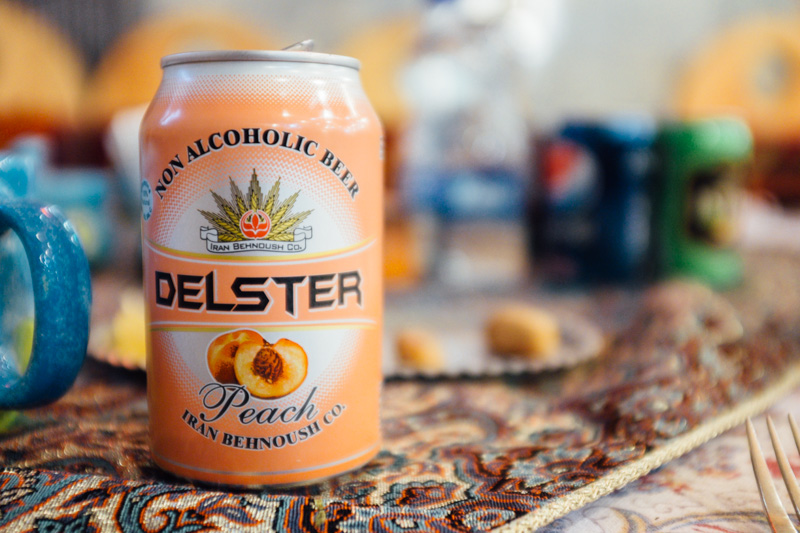
Biriyani
Biriyani in Iran is quite different than what first comes to the mind of most westerners, which is Pakistani biriyani. The word biriyani actually derives from “birinj”, the Persian word for rice. Isfahan is famous for its biriyani, or berian as it’s also known. The Isfahan version is made with cooked mutton/lamb, which is stewed and minced separately, and then grilled in small round shallow pans in an oven or over an open fire. It’s served with bread, nan-e taftoun.
Name Unknown
This little shop, which had a very popular take-away window was located on Hafez Street, just off Naqsh-e Jahan Square. The staff were friendly and the food was excellent – one of the simplest, cheapest and best meals I ate in Iran.
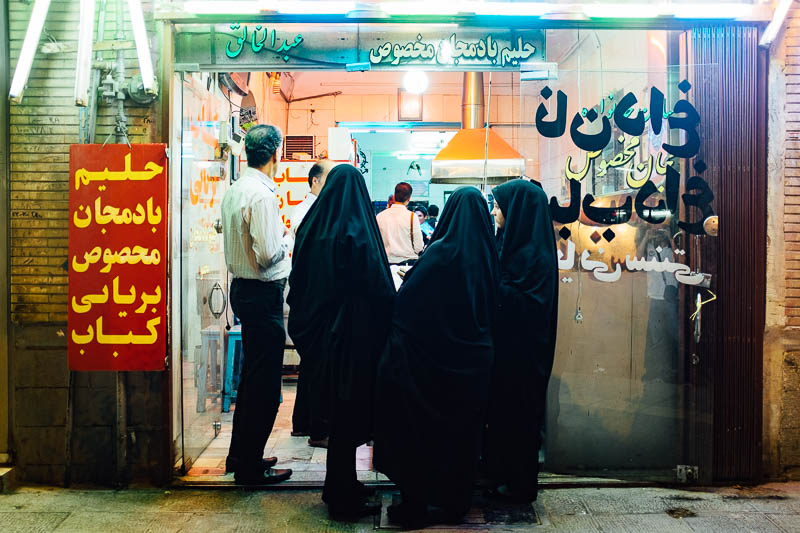
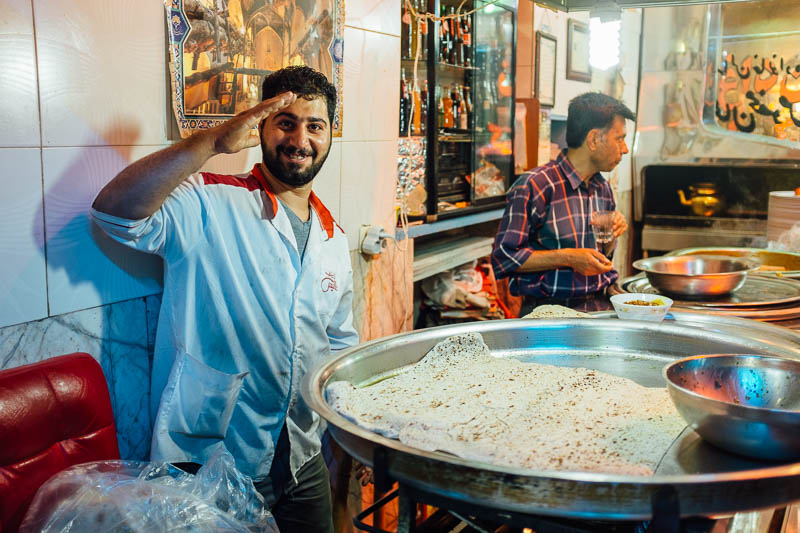
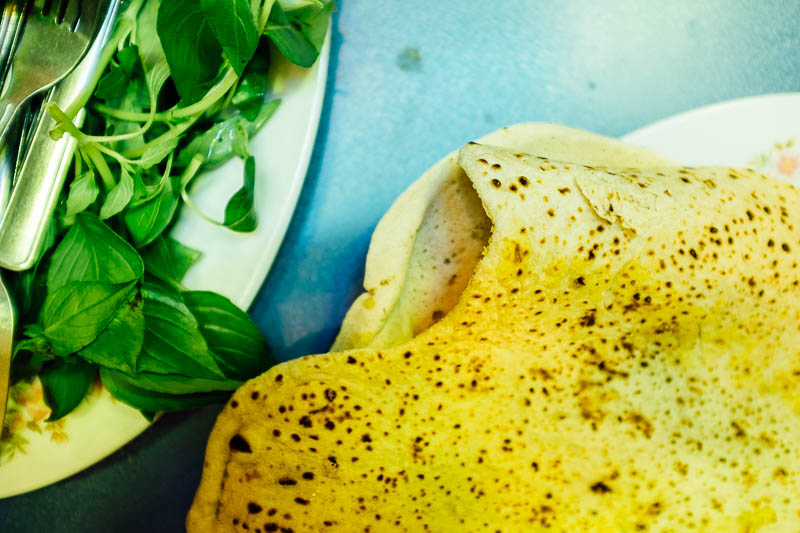
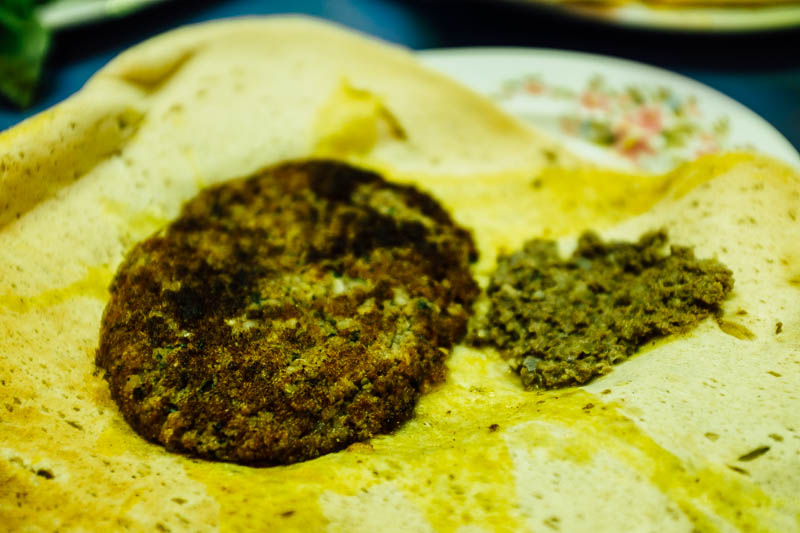
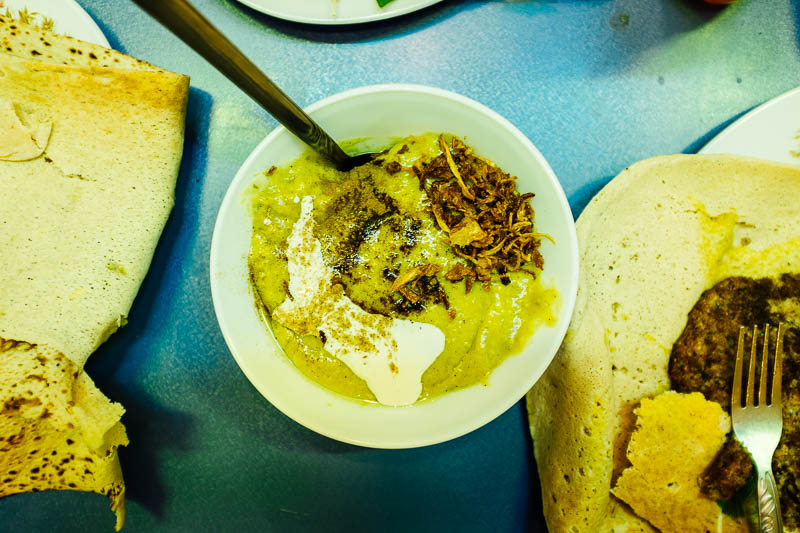
Name Unknown
Hafez Street (just off Naqsh-e Jahan Square)
Isfahan
Street Food
Bazaar of Esfahan
You can find almost anything that you want at the Bazaar of Esfahan, including a wide variety of food items. If you want to stock up on some herbs and spices to bring back home to your kitchen, it doesn’t get much better than the freshly ground mounds on offer here.
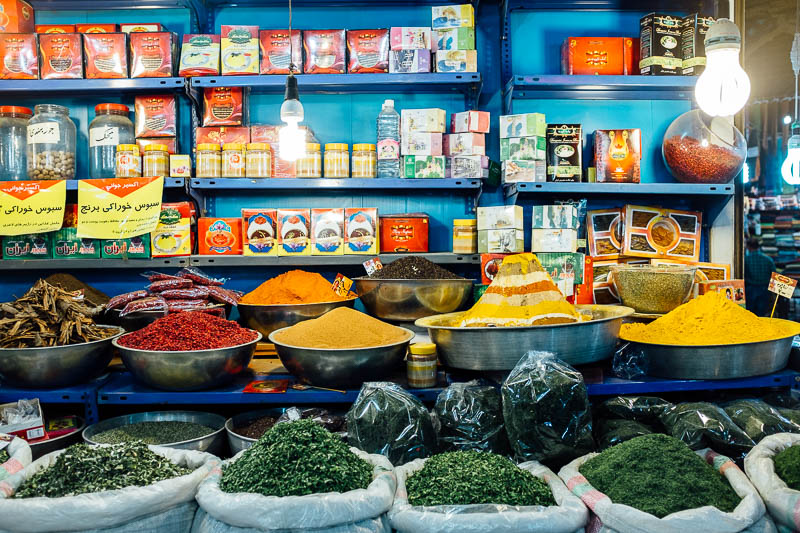
Gojeh Sabz are sour green plums which haven’t fully ripened. They are eaten raw with a coating of salt, giving a contrasting flavour to each bite. Despite being extremely sour, they are very addictive!
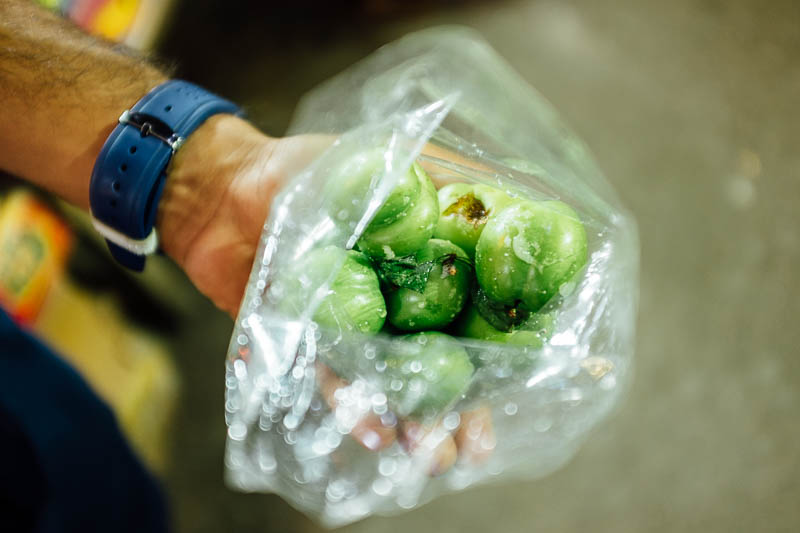
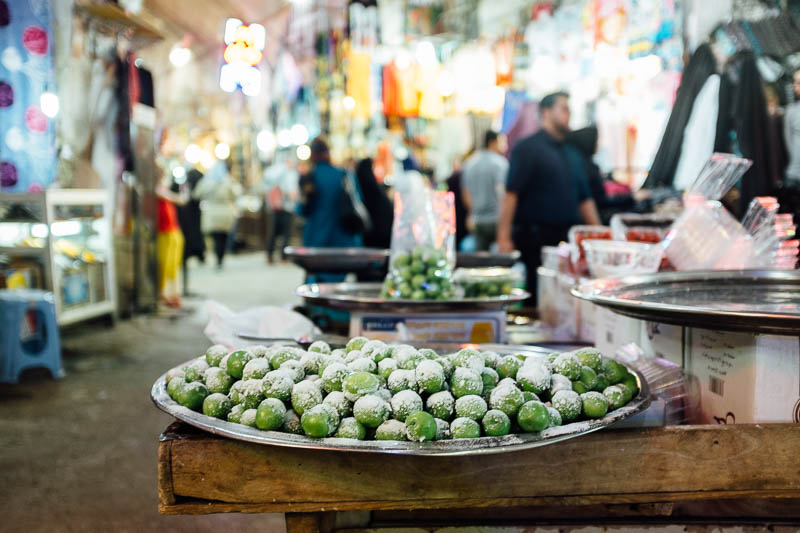
Fast Food
Western-style fast food is much more common in Iran than I had anticipated. Burgers, fried chicken, pizza, whatever – you want it, you can find it. For reasons political and otherwise you won’t find the ubiqutous Western chains in Iran but where there’s a will there’s a way and there are a lot of independent shops doing their own take. The place below, for example, is not KFC or Pizza Hut, but you’ll find SFC, ZFC and any other number of KFC and Pizza Hut knock-offs in Esfahan and throughout Iran’s major cities. It’s one of those things that makes you realise the kind of things that sanctions cause that you never really thought about – regular Iranians can’t get their fix of actual KFC when they want it.
The places below were all located around Middle Nazar Street and East Nazar Street in Esfahan’s Jolfa district, which is very popular with young people.
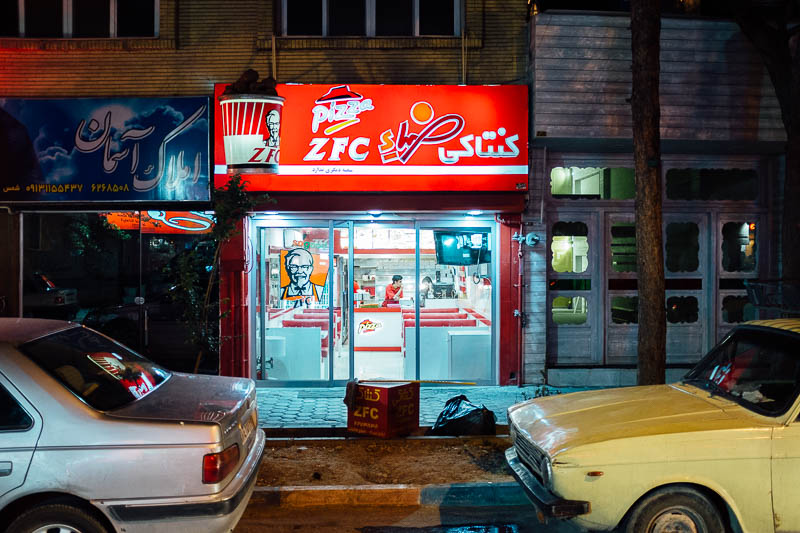
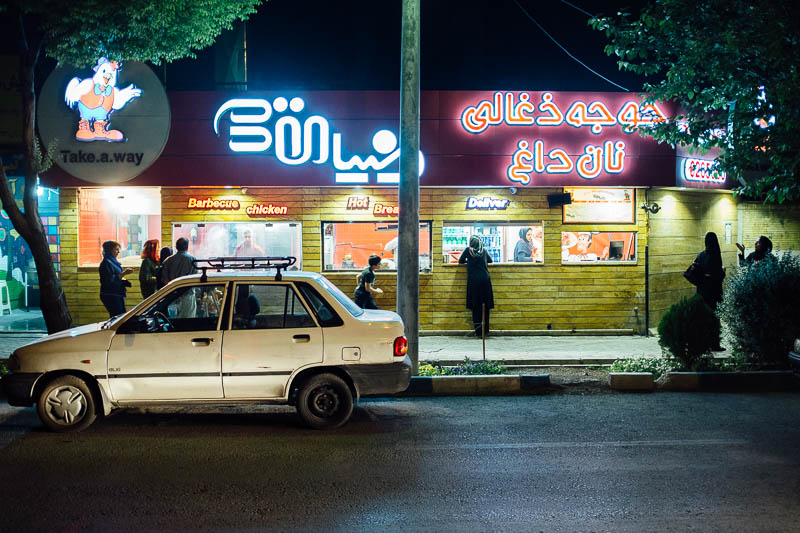
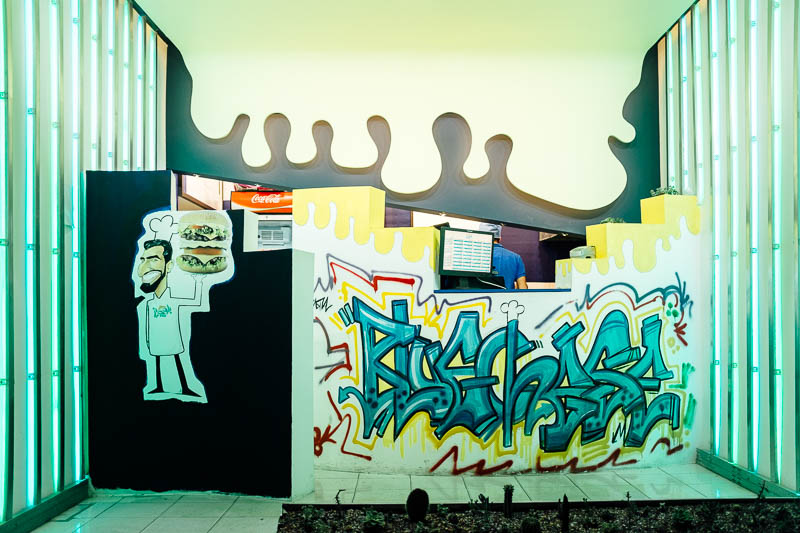
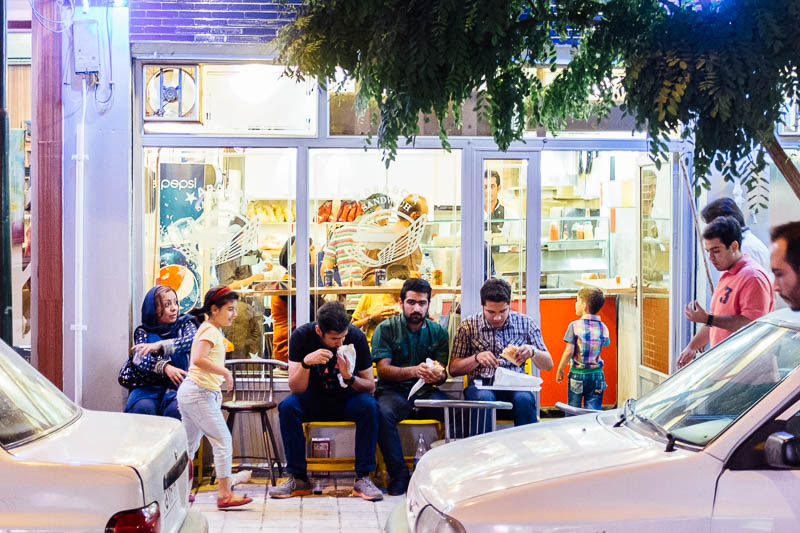
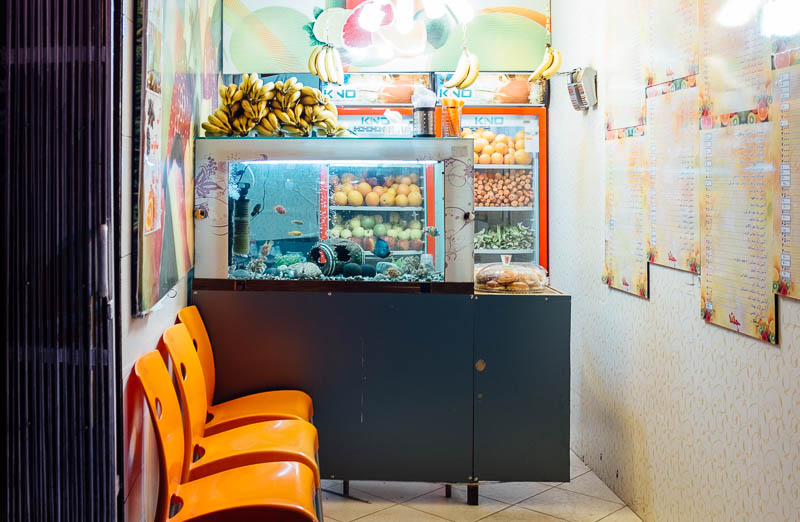
This place was so popular that I had to go in and get something. I didn’t know exactly what it was that I had ordered but a few minutes later, out came something which I guess could best be described as a sort of a felafel meets Iranian mini calzone. It was really tasty – no wonder the place was popular.
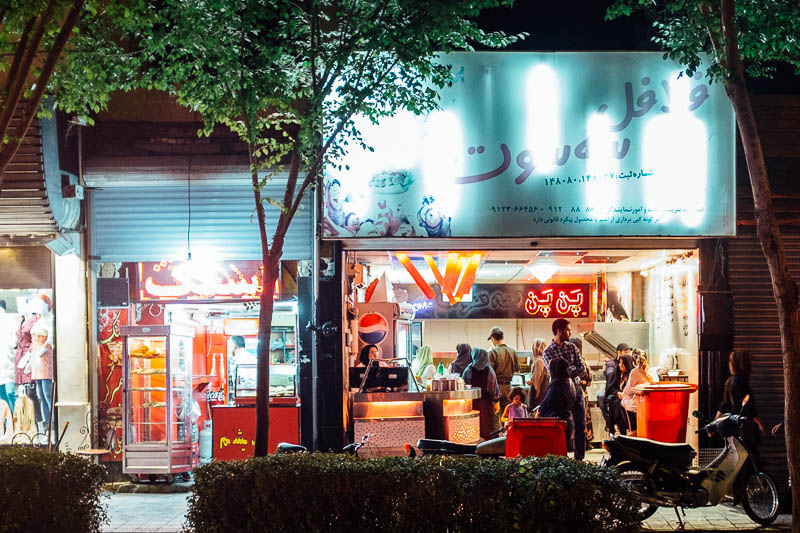
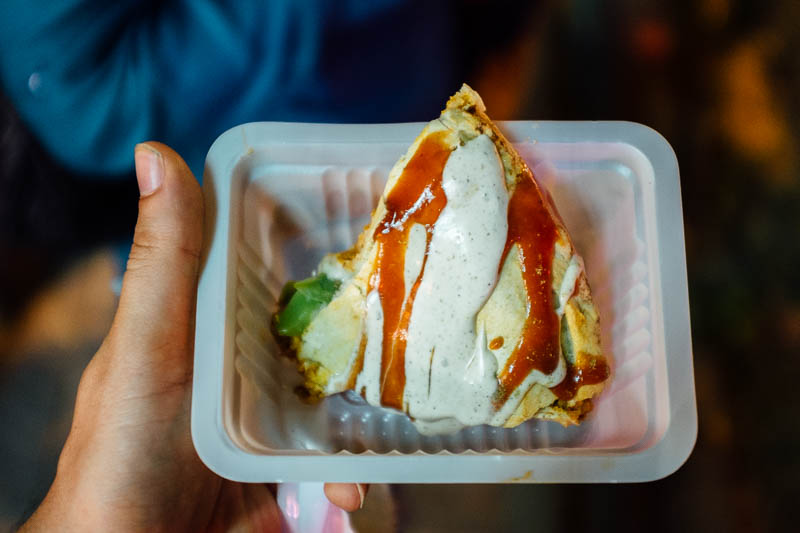
Cakes, Sweets & Nuts
Cakes, sweets and nuts. All very common throughout Iran and it’s easy to find shops that sell all 3 in the same place. Walk inside and grab a pastry or a bag of something that tickles your fancy from the large selection on offer in most shops. No need to give addresses here – these shops are everywhere.
Syrup Pudding
I found a dessert at this little shop that I have been unable to find the name for. Thankfully you don’t need to know what it’s called in order to enjoy it. It’s a yoghurt-like pudding served cold in a sweet honey syrup that’s utterly delicious.
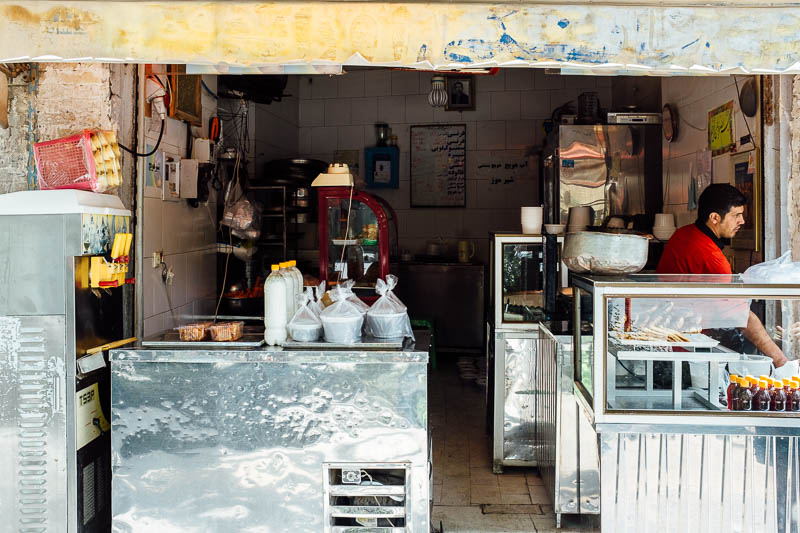
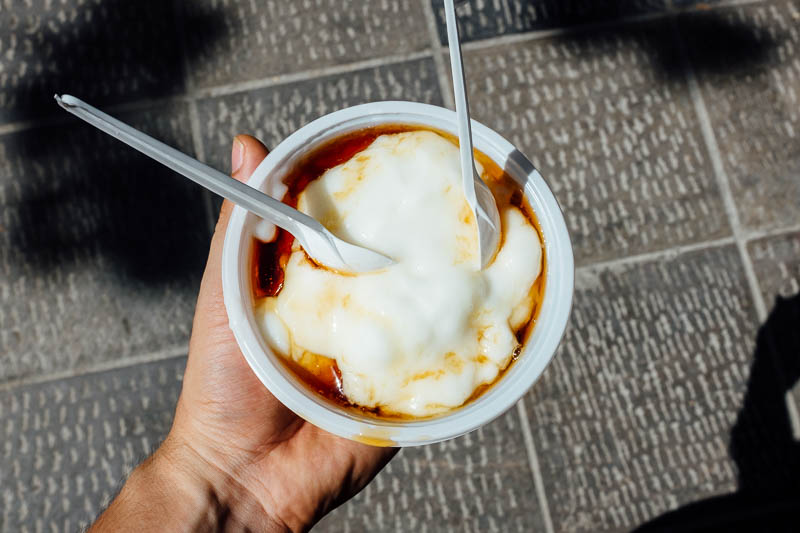
Name Unknown
Hafez Street (about a 2 minute walk up from Naqsh-e Jahan Square)
Isfahan
Bamiyeh
Bamiyeh are made from a yogurt and starch based dough, which is fried before being dipped in syrup. They are tasty, but very sweet.
These ones were from the dessert place above that also had the pudding.
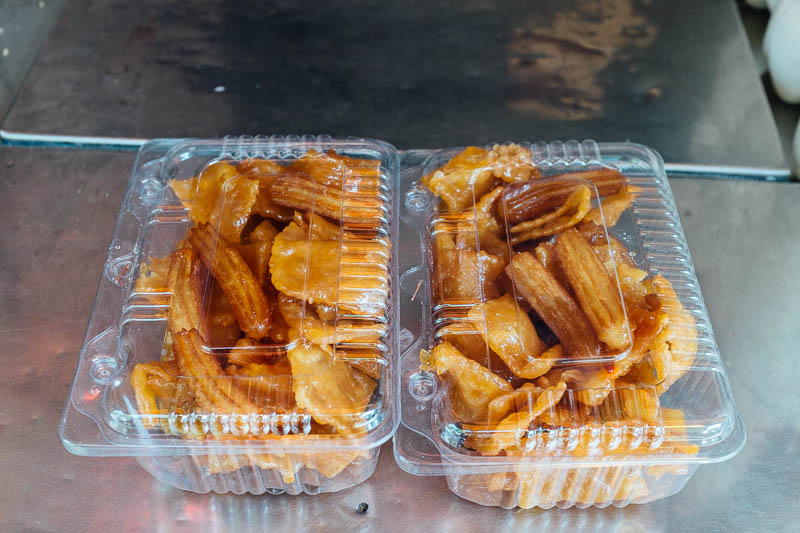
These ones, which weren’t quite as good as the above, were from Azadegan Tea House.
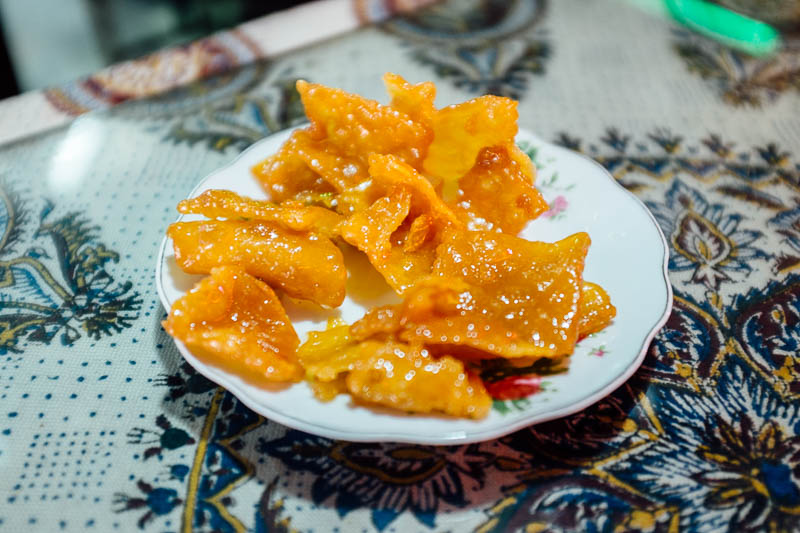
Faloodeh
Faloodeh is a cold dessert which contains thin corn starch vermicelli noodles, mixed in a semi-frozen rosewater syrup. It’s common throughout Iran, but originated in Shiraz and is brilliant not just for its sweet rosewater taste but for the crunchy texture that the noodles provide.
Ice Cream Patee Pol
A place that was consistently busy was Ice Cream Patee Pol which, along with selling ice-cream sold faloodeh, which was easily the most popular thing being ordered.
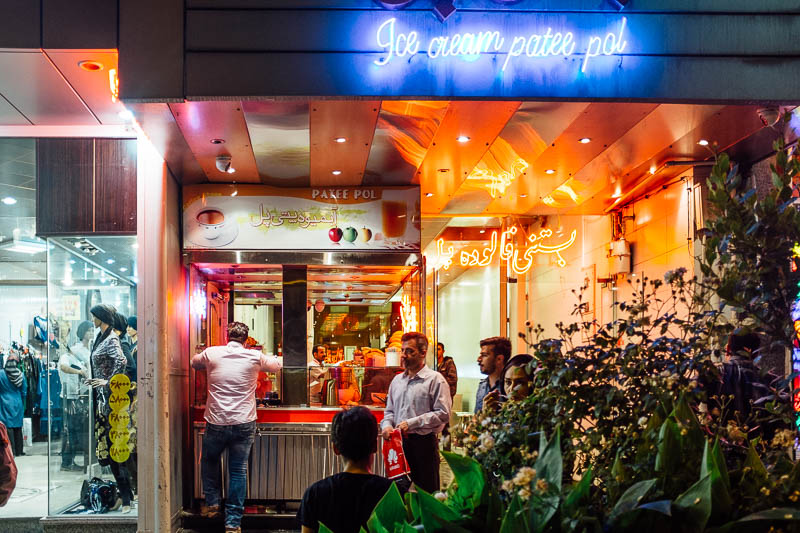
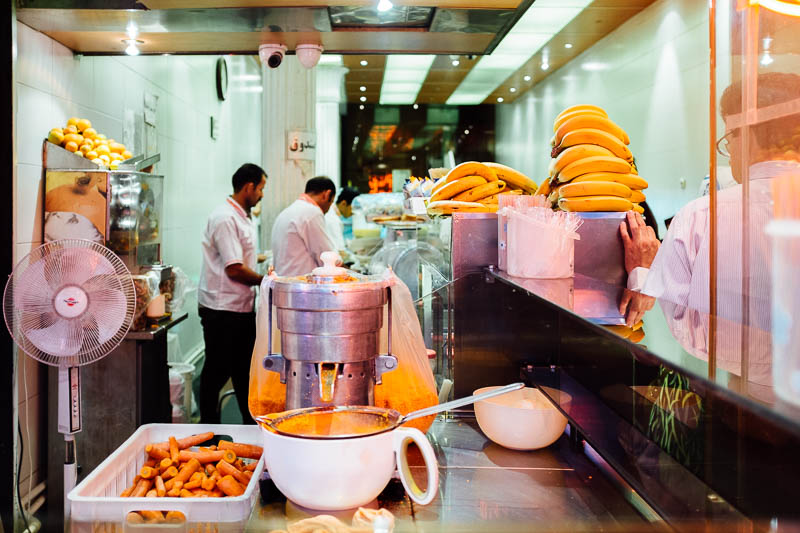
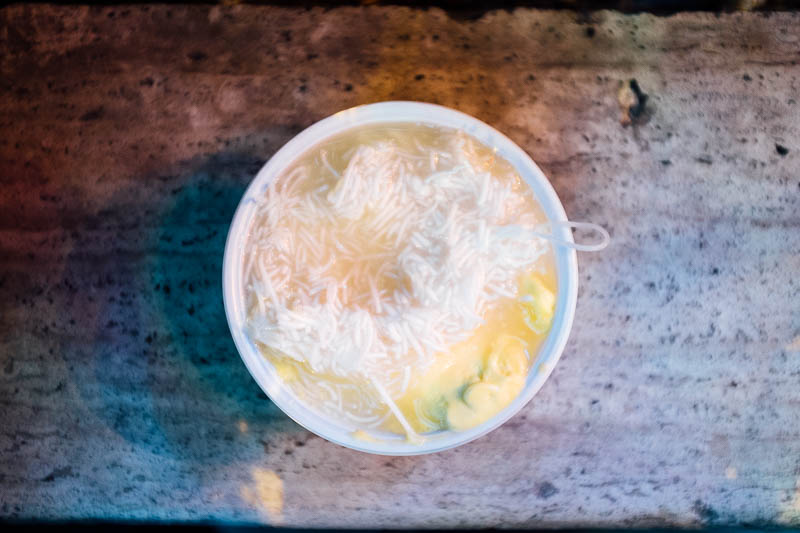
Ice Cream Patee Pol
Chahar Bagh e Bala Avenue (first block of shops, just up from the intersection with Melat Boulevard)
Esfahan
Gaz
Gaz is a very popular Persian soft nougat which originated in Esfahan. There’s plain gaz, gaz with nuts, with rosewater, saffron etc.
Meraj Gaz
Meraj Gaz has been around since 1956 and today has several shops. As you can see in the photo below, there’s no shortage of gaz to choose from.
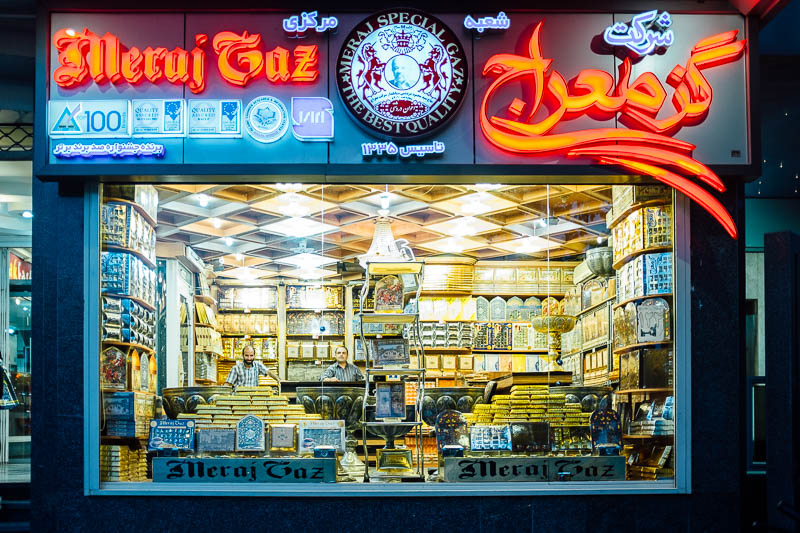
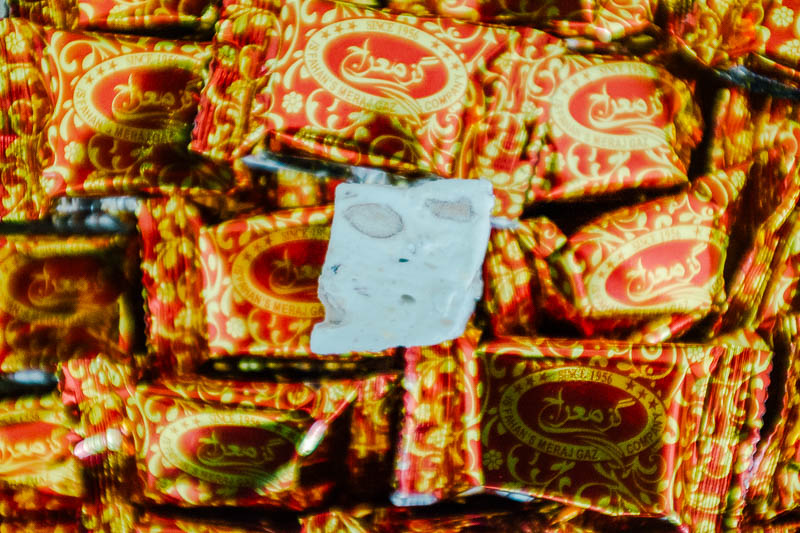
Meraj Gaz
Chahar Bagh e Bala Avenue (first block of shops, just up from the intersection with Melat Boulevard)
Esfahan
Other
There are several other delicacies which you can try in Esfahan. We didn’t try everything in Esfahan as we spread out our eating over several cities across 15 days. Delicacies you may come across during your time in Esfahan that are worth trying include:
- Pashmak (Sugar & sesame seed Persian fairy floss/cotton candy)
- Ab-Haveej Bastani (Carrot juice and vanilla ice-cream float)
- Abgoosht, or Dizi (lamb, chickpeas, white beans, onion, potatoes, tomatoes, turmeric, and dried lime that have been cooked into a stew then mashed and served with the broth)
You’ll be able to read more about these other foods, including additional food not commonly found in Esfahan in our Tehran Food Guide and Shiraz Food Guide.
If you’re from Esfahan or have visited and have got any tips of your own I’d love to hear about them in the comments section below.

